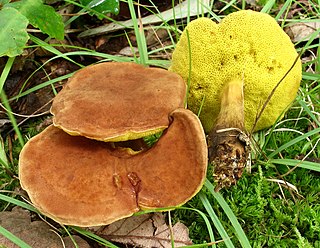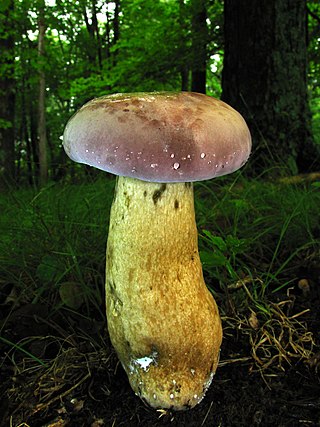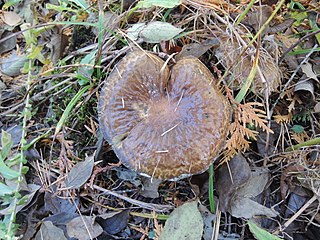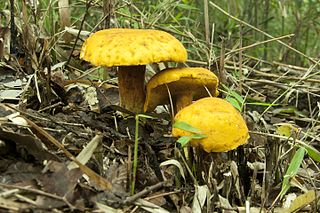
Caloboletus calopus, commonly known as the bitter beech bolete or scarlet-stemmed bolete, is a fungus of the bolete family, found in Asia, Northern Europe and North America. Appearing in coniferous and deciduous woodland in summer and autumn, the stout fruit bodies are attractively coloured, with a beige to olive cap up to 15 cm (6 in) across, yellow pores, and a reddish stipe up to 15 cm (6 in) long and 5 cm (2 in) wide. The pale yellow flesh stains blue when broken or bruised.

Exsudoporus frostii, commonly known as Frost's bolete or the apple bolete, is a bolete fungus first described scientifically in 1874. A member of the family Boletaceae, the mushrooms produced by the fungus have tubes and pores instead of gills on the underside of their caps. Exsudoporus frostii is distributed in the eastern United States from Maine to Georgia, and in the southwest from Arizona extending south to Mexico and Costa Rica. A mycorrhizal species, its fruit bodies are typically found growing near hardwood trees, especially oak.

Xerocomellus zelleri, commonly known as Zeller's bolete, is an edible species of mushroom in the family Boletaceae. First described scientifically by American mycologist William Alphonso Murrill in 1912, the species has been juggled by various authors to several genera, including Boletus, Boletellus, and Xerocomus. Found solely in western North America from British Columbia south to Mexico, the fruit bodies are distinguished by their dark reddish brown to nearly black caps with uneven surfaces, the yellow pores on the underside of the caps, and the red-streaked yellow stems. The fungus grows in summer and autumn on the ground, often in Douglas fir forests or on their margins. The development of the fruit bodies is gymnocarpic, meaning that the hymenium appears and develops to maturity in an exposed state, not enclosed by any protective membrane.

Charles Christopher Frost was an American mycologist. He described several species of fungi from the New England area of the United States. In one paper, Frost described 22 new species of boletes, and he was later credited with the discovery of three additional species. His personal herbarium of specimens were given to the University of Vermont in 1902. Portions of his collection today are distributed between the Farlow Herbarium at Harvard University, the New York State Museum, the Bell Museum of Natural History, and the Buffalo Museum of Science.

Tylopilus tabacinus is a species of bolete fungus in the family Boletaceae. It is characterized by a tawny-brown cap measuring up to 17.5 cm (6.9 in) in diameter, and a reticulated stem up to 16.5 cm (6.5 in) long by 6 cm (2.4 in) thick. A characteristic microscopic feature is the distinctive crystalline substance encrusted on the hyphae in the surface of the cap. The species is known from the eastern United States from Florida north to Rhode Island, and west to Mississippi, and from eastern Mexico. It is a mycorrhizal species, and associates with oak and beech trees.

Aureoboletus innixus is a species of bolete fungus in the family Boletaceae. Found in eastern North America, it was first described scientifically by Charles Christopher Frost in 1874, from collections made in New England. An edible mushroom, the convex cap grows to 3–8 cm (1.2–3.1 in) wide and is dull reddish brown to yellow brown. The stem is 3–6 cm (1.2–2.4 in) long by 1–1.6 cm (0.4–0.6 in) thick, but often swollen at the apex with a tapered base. It has a bright yellow pore surface when young that dulls in color when mature. There are about 1 to 3 pores per mm when young, but they expand as they mature to about 2 mm wide. The spore print is olive-brown, and the spores are ellipsoid, smooth, and measure 8–11 by 3–5 um.

Boletus carminiporus is a species of bolete fungus in the family Boletaceae. Described as new to science in 1998, the species is found in the southern United States where it grows in a mycorrhizal association with various trees in mixed forests.

Boletus miniato-olivaceus is a species of bolete fungus in the family Boletaceae. Described as new to science in 1874, it is found in eastern North America and northeast Mexico.

Phylloporus leucomycelinus is a species of bolete fungus in the family Boletaceae. First described in 1978, it is found in eastern North America and the Philippines.

Pulveroboletus ravenelii, commonly known as Ravenel's bolete or the powdery sulfur bolete, is a species of bolete fungus in the family Boletaceae. Described as new to science in 1853, the widely distributed species is known from Asia, Australia, North America, Central America, and South America. Mycorrhizal with oak, the fungus fruits on the ground singly, scattered, or in groups in woods. Fruit bodies (mushrooms) have convex to flat, yellowish to brownish-red caps up to 10 cm (4 in) in diameter. On the cap underside, the pore surface is bright yellow before turning dingy yellow to grayish brown with age; it stains greenish blue then grayish brown after injury. A cottony and powdery partial veil remains as a ring on the stipe. The mushrooms are edible, and have been used in traditional Chinese medicine and for mushroom dyeing.

Tylopilus rubrobrunneus, commonly known as the reddish brown bitter bolete, is a bolete fungus in the family Boletaceae. It was first described scientifically in 1967 by Samuel J. Mazzer and Alexander H. Smith from collections made in Michigan. It is found in the United States; the bolete was reported from a Mexican beech forest in Hidalgo, Mexico in 2010.

Leccinellum albellum is a species of bolete fungus in the family Boletaceae. Originally described by Charles Horton Peck as a species of Boletus, and, after 1945, usually considered a species of Leccinum, it was transferred to the newly created genus Leccinellum in 2003. The bolete was reported from a Mexican beech forest in Hidalgo, Mexico in 2010.

Caloboletus firmus is a bolete fungus native to North America. Until 2014, it was known as Boletus firmus. Recent changes in the phylogenetic framework of the family Boletaceae prompted the transfer of this species, along with several other related boletes, including Caloboletus calopus, to the genus Caloboletus. It was first described scientifically in 1874 by American botanist Charles Christopher Frost from specimens collected in New England.

Harrya chromapes, commonly known as the yellowfoot bolete or the chrome-footed bolete, is a species of bolete fungus in the family Boletaceae. The bolete is found in eastern North America, Costa Rica, and eastern Asia, where it grows on the ground, in a mycorrhizal association with deciduous and coniferous trees. Fruit bodies have smooth, rose-pink caps that are initially convex before flattening out. The pores on the cap undersurface are white, aging to a pale pink as the spores mature. The thick stipe has fine pink or reddish dots (scabers), and is white to pinkish but with a bright yellow base. The mushrooms are edible but are popular with insects, and so they are often infested with maggots.

Suillus serotinus is a species of bolete fungus found in eastern North America. Originally described as a species of Boletus by American botanist Charles Christopher Frost in 1874, it was transferred to Suillus in 1996. The bolete has a dark red brown and sticky cap up to 12 cm (4.7 in) in diameter. The pore surface is initially white before turning reddish brown in age; the angular pores number from 1 to 3 per millimeter. Mushroom flesh slowly stains bluish after injury, later becoming purplish gray then finally reddish brown. The fungus grows in a mycorrhizal association with larch and fruits on the ground scattered or in groups. The spore print is purplish brown; spores are oblong to ellipsoid, smooth, and measure 8–12 by 4–5 µm. The fruit bodies are edible, but lack any distinctive taste or odor.

Tylopilus sordidus is a bolete fungus in the family Boletaceae. It was originally described in 1874 by Charles Christopher Frost as a species of Boletus. Alexander H. Smith and Harry Thiers transferred it to the genus Tylopilus in 1968. Fruit bodies of the fungus have a convex to flattened cap measuring 4.5–13 cm (1.8–5.1 in) in diameter. The brownish cap surface is initially tomentose to felt-like, but develops cracks in age. All parts of the mushrooms bruise dark blue to greenish when injured. The spore print is reddish brown; spores are smooth, roughly elliptical, and measure 10–14 by 4–6 µm. The bolete is found in North America, where it grows on the ground under oaks and conifers. Its edibility was recently unknown, but it is now considered inedible.
Boletus roseolateritius is a bolete fungus found in the southern United States and northeast Mexico. It was described as a new species in 2003 by Alan Bessette, Ernst Both, and Dail Dunaway. The type collection was made in Mississippi, where it was found growing on the ground under American beech, near hickory and oak. The bolete was reported from a Mexican beech forest in Hidalgo, Mexico in 2010.

Sutorius eximius, commonly known as the lilac-brown bolete, is a species of fungus in the family Boletaceae. This bolete produces fruit bodies that are dark purple to chocolate brown in color with a smooth cap, a finely scaly stipe, and a reddish-brown spore print. The tiny pores on the cap underside are chocolate to violet brown. It is widely distributed, having been recorded on North America, South America, and Asia, where it grows in a mycorrhizal relationship with both coniferous and deciduous trees.

Boletus aurantiosplendens is a species of fungus native to eastern North America. Timothy J Baroni described the species in 1998, from material collected near Franklin in Macon County, North Carolina. The species name is from the Latin words aurantium "orange", and splendens "bright".


















